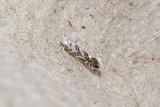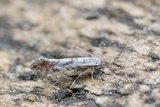Phyllonorycter geniculella (Ragonot, 1874) Species
Last modified: Dec. 14, 2024, 3:55 p.m.
A widespread and rather common species in Belgium.
Details
- Classification
- Family: Gracillariidae > Subfamily: Lithocolletinae > Genus: Phyllonorycter > Species: Phyllonorycter geniculella
- Vernacular names
- Gewone esdoornvouwmot (NL), Sycamore midget (EN), Bergahorn-Faltenminiermotte (DE)
- Synonyms
- Phyllonorycter acernella sensu auct., nec (Duponchel, 1843)
- First mention in Belgium
- De Crombrugghe G. 1905. Note sur quelques Microlépidoptères de la faune belge. — Annales de la Société Entomologique de Belgique 49: 100–107. On page 106. view page
- Status
-
Native
Distribution
Imago
Head white; forewing ground colour white with golden-brown pattern consisting of two very small striae at the base, one costal the other dorsal; two chevrons, touching each other, pointing apically and a thin transverse band before the apex. In the two other Acer feeding Phyllonorycter species, Ph. acerifoliella and Ph. joannisi, the second costal and dorsal striae do not form a chevron, but are merged in the center to form a transverse band.
Mine
At first, a very inconspicuous serpentine mine on the underside of a leaf. Later on, a rather broad tentiform mine, most of the time over the serpentine mine. Epidermis with several longitudinal folds. When the mine is situated close to the leaf margin, the leaf is folded downwards over it. The black frass is concentrated in a corner of the mine.
See also gracillariidae.net and bladmineerders.be.
Cocoon/pupa
Flimsy white cocoon, pupa dark brown to blackish.
Bionomics
The egg is oviposited on the underside of a leaf, close to a vein.
The species hibernates in the pupal stage, inside the cocoon between fallen leaves among leaf leaf litter on the ground.
Flight periods
Two generations a year in April–May and from July till September.
Observed on
- Host plant (species):
- Acer pseudoplatanus
A monophagous species, living on Acer pseudoplatanus.


